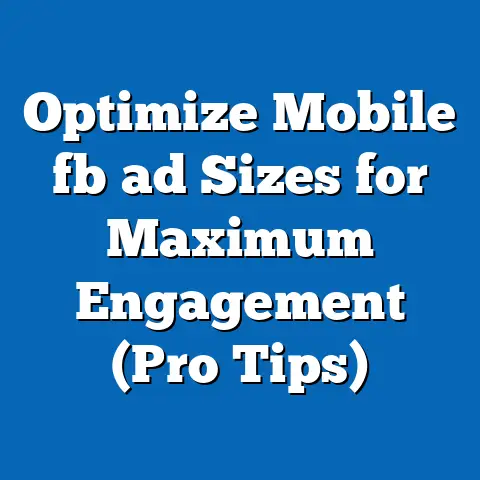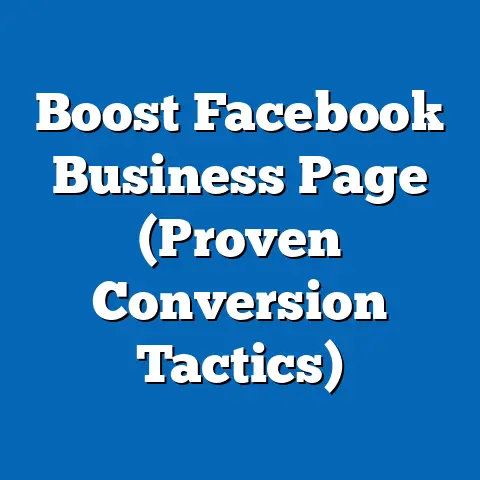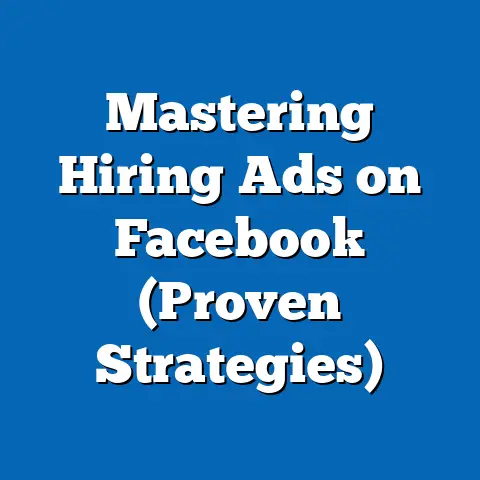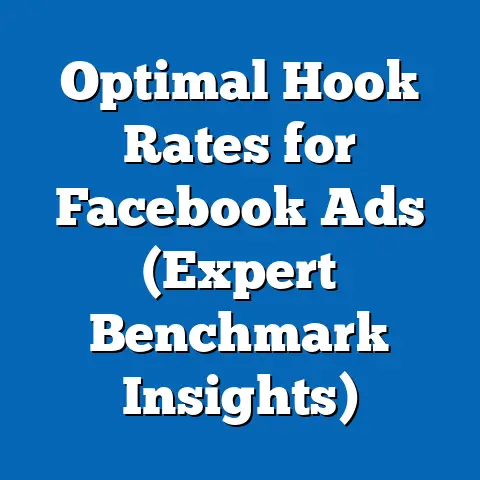Boost ROAS with Facebook Ads (Proven Strategies)
In the dynamic world of digital marketing, every penny counts. Return on Advertising Spend (ROAS) is the compass that guides us, showing whether our efforts are truly paying off. Facebook Ads, a powerful platform with billions of users, offers incredible potential to boost your marketing efforts and achieve a higher ROAS. But potential alone isn’t enough. It’s about knowing the right strategies and implementing them effectively.
Understanding ROAS
ROAS, or Return on Advertising Spend, is the lifeblood of any successful advertising campaign. It’s a metric that measures the revenue generated for every dollar spent on advertising. In simple terms, it tells you if your ads are making money or losing it. Understanding ROAS is crucial because it allows you to evaluate the effectiveness of your advertising campaigns and make informed decisions about where to allocate your budget.
Calculating ROAS
The formula for calculating ROAS is straightforward:
ROAS = (Revenue Generated from Ads / Advertising Spend) x 100
For example, if you spend $1,000 on Facebook Ads and generate $5,000 in revenue, your ROAS would be:
ROAS = ($5,000 / $1,000) x 100 = 500%
This means that for every dollar you spent on ads, you generated $5 in revenue. A higher ROAS indicates a more profitable advertising campaign.
ROAS vs. ROI
While ROAS and ROI (Return on Investment) are both important performance indicators, they measure different aspects of your business. ROI takes into account all costs associated with a project or investment, including expenses like salaries, overhead, and production costs. ROAS, on the other hand, focuses solely on the revenue generated from advertising spend.
ROAS is specifically relevant to advertising because it helps you understand the direct impact of your ad campaigns on revenue. It allows you to compare the performance of different campaigns, ad sets, and ads to identify what’s working best. ROI provides a broader view of overall profitability, but ROAS gives you a laser focus on advertising effectiveness.
Takeaway: ROAS is a critical metric for evaluating the performance of your Facebook Ads campaigns. It measures the revenue generated for every dollar spent on advertising, helping you make informed decisions about budget allocation and campaign optimization.
Setting Up the Right Facebook Ads Campaign
Setting up a Facebook Ads campaign with the goal of maximizing ROAS requires careful planning and attention to detail. It’s not just about throwing money at ads; it’s about strategically targeting the right audience, crafting compelling ad content, and optimizing your campaigns for the best results.
Identifying Campaign Objectives
The first step in setting up a successful Facebook Ads campaign is to clearly define your campaign objectives. What do you want to achieve with your ads? Are you looking to increase brand awareness, drive traffic to your website, generate leads, or boost sales?
Common campaign objectives include:
- Conversions: Driving specific actions on your website, such as purchases, sign-ups, or form submissions.
- Traffic: Sending users to your website or landing page.
- Engagement: Increasing likes, shares, comments, and other interactions with your ads.
- Lead Generation: Collecting contact information from potential customers.
- Brand Awareness: Increasing the visibility of your brand and reaching a wider audience.
Choosing the right campaign objective is crucial because it tells Facebook’s algorithm what you want to achieve. This helps Facebook optimize your ads to reach the people who are most likely to take the desired action.
Audience Targeting and Segmentation
Audience targeting is the process of identifying and reaching the specific group of people who are most likely to be interested in your products or services. Facebook offers a wide range of targeting options, allowing you to narrow down your audience based on demographics, interests, behaviors, and more.
Segmentation involves dividing your audience into smaller, more specific groups based on shared characteristics. This allows you to tailor your ad content to resonate with each group, increasing the likelihood of engagement and conversions.
Audience Research and Buyer Personas
Conducting thorough audience research is essential for effective targeting and segmentation. Start by gathering data about your existing customers, including their demographics, interests, purchase history, and online behavior.
Create buyer personas, which are fictional representations of your ideal customers. These personas should include detailed information about their demographics, motivations, pain points, and goals. Use this information to tailor your ad content and targeting to resonate with each persona.
I once worked with a client who was selling high-end coffee beans. Initially, they were targeting a broad audience with generic ad content. After conducting audience research and creating buyer personas, we discovered that their ideal customers were coffee enthusiasts who valued quality, sustainability, and unique flavors. We then created ad content that highlighted these aspects of their products and targeted users who were interested in specialty coffee, ethical sourcing, and gourmet food. As a result, their ROAS increased by 300%.
Ad Placements
Facebook offers a variety of ad placements, including:
- Facebook Feed: Ads that appear in users’ news feeds.
- Instagram Feed: Ads that appear in users’ Instagram feeds.
- Facebook Marketplace: Ads that appear in the Facebook Marketplace.
- Facebook Stories: Full-screen ads that appear between users’ stories.
- Instagram Stories: Full-screen ads that appear between users’ Instagram stories.
- Facebook Right Column: Ads that appear in the right column of the Facebook website.
- Audience Network: Ads that appear on third-party websites and apps.
Testing multiple placements is crucial to identify which yield the best results for your campaigns. Some placements may perform better than others depending on your target audience, ad content, and campaign objectives.
Takeaway: Setting up the right Facebook Ads campaign involves identifying clear objectives, conducting thorough audience research, creating buyer personas, and testing multiple ad placements. This strategic approach will help you maximize your ROAS and achieve your advertising goals.
Crafting Compelling Ad Content
Crafting compelling ad content is essential for capturing attention, engaging your target audience, and driving conversions. High-performing ad creatives include visuals, copy, and a clear call-to-action that prompts users to take the desired action.
Elements of High-Performing Ad Creatives
- Visuals: Use high-quality images or videos that are visually appealing and relevant to your products or services.
- Copy: Write concise, persuasive copy that highlights the benefits of your products or services and addresses the needs and pain points of your target audience.
- Call-to-Action: Include a clear and compelling call-to-action that tells users what you want them to do, such as “Shop Now,” “Learn More,” or “Sign Up.”
The Power of Storytelling
Storytelling is a powerful tool for engaging your target audience and building a connection with your brand. Share stories that resonate with your audience’s values, emotions, and aspirations.
For example, if you’re selling fitness products, share stories of people who have transformed their lives through fitness. If you’re selling travel packages, share stories of people who have had unforgettable travel experiences.
A/B Testing Ad Creatives
A/B testing involves creating two or more versions of your ad creatives and testing them against each other to see which performs best. This allows you to identify the elements that resonate most with your target audience and optimize your ads for better results.
Test different versions of your visuals, copy, and call-to-action to see what drives the most engagement and conversions.
Examples of Successful Ad Campaigns
One example of a successful ad campaign is Dollar Shave Club’s viral video, which used humor and wit to promote their razor subscription service. The video was low-budget but highly engaging, and it helped Dollar Shave Club gain a large following and disrupt the traditional razor market.
Another example is Nike’s “Just Do It” campaign, which features inspiring stories of athletes overcoming challenges and achieving their goals. The campaign resonates with people of all ages and backgrounds and has helped Nike become one of the most recognizable and respected brands in the world.
Takeaway: Crafting compelling ad content involves using high-quality visuals, writing persuasive copy, including a clear call-to-action, and leveraging the power of storytelling. A/B testing different versions of your ad creatives will help you identify what resonates best with your target audience and optimize your ads for better results.
Leveraging Facebook’s Ad Tools and Features
Facebook offers a wide range of ad tools and features that can help you optimize your campaigns for better ROAS. These tools allow you to track conversions, retarget potential customers, create lookalike audiences, and more.
Facebook Pixel
The Facebook Pixel is a piece of code that you can install on your website to track conversions and gather valuable data about your website visitors. This data can be used to optimize your ad campaigns and target the people who are most likely to convert.
The Facebook Pixel allows you to track a variety of events, such as:
- Page Views: Tracking which pages users visit on your website.
- Add to Cart: Tracking when users add products to their shopping carts.
- Initiate Checkout: Tracking when users begin the checkout process.
- Purchase: Tracking when users complete a purchase.
By tracking these events, you can gain valuable insights into your website visitors’ behavior and use this information to optimize your ad campaigns.
Dynamic Ads and Retargeting
Dynamic ads are ads that automatically show the most relevant products or services to each user based on their browsing history and interests. Retargeting involves showing ads to people who have previously visited your website or interacted with your business.
These strategies can be highly effective for driving conversions and increasing ROAS because they target people who are already familiar with your brand and products.
I once worked with an e-commerce client who was struggling to convert website visitors into customers. We implemented dynamic ads and retargeting strategies, showing ads to people who had viewed specific products on their website but hadn’t made a purchase. As a result, their conversion rate increased by 50%.
Lookalike Audiences and Custom Audiences
Lookalike audiences are audiences that are similar to your existing customers or website visitors. Facebook uses its data to identify people who share similar demographics, interests, and behaviors with your existing audience.
Custom audiences are audiences that you create based on your own data, such as email lists, phone numbers, or website visitors.
These features can help you expand your reach and target new potential customers who are likely to be interested in your products or services.
Takeaway: Leveraging Facebook’s ad tools and features, such as the Facebook Pixel, dynamic ads, retargeting, lookalike audiences, and custom audiences, can help you optimize your campaigns for better ROAS. These tools allow you to track conversions, target potential customers, and expand your reach to new audiences.
Analyzing and Optimizing Campaign Performance
Analyzing and optimizing campaign performance is an ongoing process that involves monitoring key performance indicators (KPIs), analyzing campaign data, and making data-driven decisions to improve your ROAS.
Key Performance Indicators (KPIs)
Key performance indicators (KPIs) are metrics that you use to track the performance of your ad campaigns. Common KPIs include:
- ROAS: Return on Advertising Spend.
- Cost Per Conversion: The cost of acquiring a conversion, such as a purchase or sign-up.
- Click-Through Rate (CTR): The percentage of people who click on your ads.
- Conversion Rate: The percentage of people who take the desired action after clicking on your ads.
- Cost Per Click (CPC): The cost of each click on your ads.
Monitoring these KPIs will help you understand how your campaigns are performing and identify areas for improvement.
Data-Driven Decisions
Regularly analyze your campaign data to identify trends and patterns. Use this information to make data-driven decisions about how to optimize your campaigns.
For example, if you notice that your cost per conversion is high, you may need to adjust your targeting, ad content, or landing page to improve your conversion rate. If you notice that your click-through rate is low, you may need to improve your ad copy or visuals to make your ads more appealing.
Optimizing Campaigns
Based on your performance insights, take action to optimize your campaigns. This may involve:
- Adjusting Budgets: Reallocating your budget to the ad sets or campaigns that are performing best.
- Refining Audience Targeting: Narrowing down your audience to reach the people who are most likely to convert.
- Improving Ad Content: Testing different versions of your ad creatives to see what resonates best with your target audience.
- Optimizing Landing Pages: Ensuring that your landing pages are optimized for conversions, with clear calls-to-action and a seamless user experience.
Case Studies
Many brands have successfully improved their ROAS through continuous optimization. For example, a clothing retailer increased their ROAS by 200% by implementing a retargeting strategy that showed ads to people who had viewed specific products on their website but hadn’t made a purchase. A software company increased their ROAS by 150% by refining their audience targeting to reach people who were more likely to be interested in their products.
Takeaway: Analyzing and optimizing campaign performance is an ongoing process that involves monitoring KPIs, analyzing campaign data, and making data-driven decisions to improve your ROAS. By continuously testing and optimizing your campaigns, you can achieve significant improvements in your advertising effectiveness.
Conclusion
Boosting ROAS with Facebook Ads requires a strategic approach that involves careful planning, compelling ad content, and continuous optimization. By understanding the importance of ROAS, setting up the right campaigns, crafting engaging ad content, leveraging Facebook’s ad tools, and analyzing campaign performance, you can achieve significant improvements in your advertising effectiveness.
Remember to identify clear campaign objectives, conduct thorough audience research, create buyer personas, test multiple ad placements, use high-quality visuals, write persuasive copy, include a clear call-to-action, and leverage the power of storytelling.
I encourage you to implement these proven strategies in your own campaigns and continually seek ways to enhance your Facebook Ads performance for better results. The potential for significant improvements in your advertising effectiveness is within your reach. Take action today and start boosting your ROAS with Facebook Ads!






